History: 1950-1959
1950
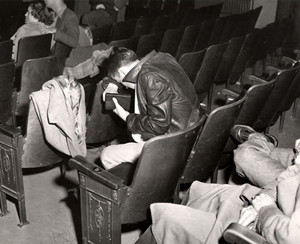 On Feb. 23, a spontaneous revival began in Hughes Auditorium. This, too, was preceded by days of special prayer. Even before the speaker could begin a student popped out of his seat to praise God for all that He had done during an all-night prayer meeting the night before. The service lasted three days without a break. Johnson, on a speaking assignment in Florida, knew nothing of this until he read a wire-service story in a local newspaper. The event received extensive news coverage and had lasting effects.
On Feb. 23, a spontaneous revival began in Hughes Auditorium. This, too, was preceded by days of special prayer. Even before the speaker could begin a student popped out of his seat to praise God for all that He had done during an all-night prayer meeting the night before. The service lasted three days without a break. Johnson, on a speaking assignment in Florida, knew nothing of this until he read a wire-service story in a local newspaper. The event received extensive news coverage and had lasting effects.
Sollie E. McCreless, a wealthy Texas insurance broker, became chairman of the College Board.
The Kentucky Day Law was amended to allow black students to attend any institution of higher learning in the state provided that its governing board approved and that the school offered a program that was not available at Kentucky State College, the state-run black college in Frankfort. Because Asbury offered ministerial and theological courses the college was legally entitled to accept black students under the provisions of this amended law. No action was taken by the Board.
In the fall the elementary education major was added with Edna Neal as the director. The numbered “Curricula” were revised again: V. became “Preparation for Teaching in Elementary Education,” VI .became “Preparation for Teaching Home Economics,” VII. became “Preparation for Medicine” and “Preparation for Law” was discontinued.
During the academic year 131 Veterans were enrolled.
In October W.D. Turkington became mayor of Wilmore.
1951
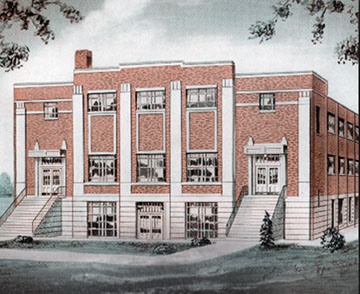 Asbury continued to share in the great postwar collegiate boom. Enrollment had doubled since 1945. This justified a series of construction projects. Construction began on a new student center, to include a gymnasium, swimming pool, college bookstore and campus post office. It was named for W.W. Holland and his wife Ethel, whose maiden name was Doddridge. The Hollands were long-time faculty members and donors to the project.
Asbury continued to share in the great postwar collegiate boom. Enrollment had doubled since 1945. This justified a series of construction projects. Construction began on a new student center, to include a gymnasium, swimming pool, college bookstore and campus post office. It was named for W.W. Holland and his wife Ethel, whose maiden name was Doddridge. The Hollands were long-time faculty members and donors to the project.
In the fall the Salvation Army Student Fellowship was formally organized on campus.
1952
In November Dwight D. Eisenhower, Republican, was elected President.
1953
On Feb. 28 College students performed “Three Little Miracles,” a short play, on WLW TV in Cincinnati. This was Asbury’s first television broadcast experience. Two other brief exposures followed in March and May
Construction began on an additional men’s dormitory, Johnson Hall East Wing. The first two floors were outfitted with a separate lobby and outside entrance, and each room had a private bath. These two floors were to serve as a College guest house.
The Kentucky State Department of Education certified the Asbury program in teacher education. This gave Asbury graduates certification in Kentucky public schools and in all states with a reciprocal agreement with Kentucky. This ended the requirement that Asbury graduates in education obtain a M.A. before being allowed to teach in another state.
1954
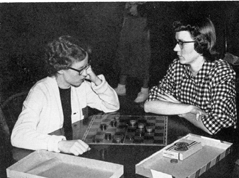 In February Asbury was formally accredited by the American Association of Colleges of Teacher Education (AACTE).
In February Asbury was formally accredited by the American Association of Colleges of Teacher Education (AACTE).
Also in February the Collegian ran a survey of 108 students, representing all regions of the country, in which strong support for the integration of both the public school system and Asbury College was expressed.
Johnson Hall, East Wing was completed. Construction began on Johnson Hall, West Wing.
In May the U.S. Supreme Court delivered its decision in the case of Brown vs. the Board of Education of Topeka Kansas, effectively ending the legal justification for racial segregation in public schools.
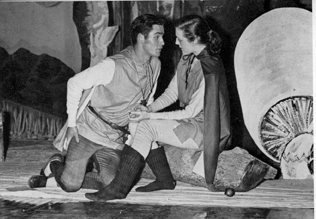 In June the salary schedule for faculty was changed in such a way that persons were paid for ten months instead of nine, with two months extra pay for summer school employment. In addition payment for the regular academic year was divided into twelve equal monthly checks.
In June the salary schedule for faculty was changed in such a way that persons were paid for ten months instead of nine, with two months extra pay for summer school employment. In addition payment for the regular academic year was divided into twelve equal monthly checks.
1955
In March the first commercial television network in Lexington, WLEX, began to broadcast.
The first McDonald’s Restaurant opened in Des Plaines, Illinois, in April.
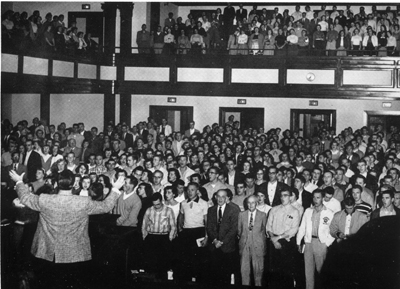 The Board responded to a request from the Student Faculty Committee to make the payment of class dues mandatory. Student leaders complained that it was difficult to collect class dues because many students were reluctant to pay.
The Board responded to a request from the Student Faculty Committee to make the payment of class dues mandatory. Student leaders complained that it was difficult to collect class dues because many students were reluctant to pay.
Men and women were forbidden to wear shorts on campus.
Parecho, a literary magazine, was launched in November, with Beth Lane as editor, Carolyn Annifer associate editor and O.C. Brown business manager.
The Montgomery Bus Boycott, organized by Martin Luther King, Jr., began in December.
1956
Johnson announced in January that he had formulated a new salary payment plan for “certain faculty members,” 13 in all. Under the plan these faculty members would be paid for twelve months’ work. These would teach summer school two years out of three, and have the third summer off free of obligation. This in effect gave these 13 persons a raise in annual salary equal to the value of two 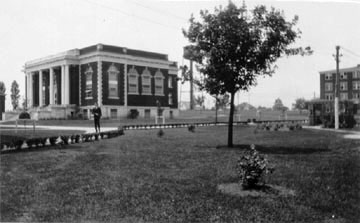 months’ pay.
months’ pay.
Clarence J. Pike became vice president and dean.
In April ground was broken for the new addition to the library, named for J.B. Kenyon, who retired this year.
In November Dwight D. Eisenhower was re-elected as President.
1957
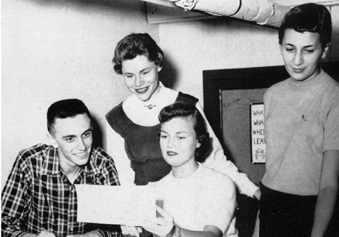 In the fall the administration conducted an extensive survey of student and faculty opinion on racial segregation. The questions were not always well phrased, but the results clearly showed a large majority in favor of integration. More than half believed Asbury was “un-christian for not admitting Negroes.” A few students declared they would leave if Asbury were integrated. The results of the complete survey were presented to the Board in January.
In the fall the administration conducted an extensive survey of student and faculty opinion on racial segregation. The questions were not always well phrased, but the results clearly showed a large majority in favor of integration. More than half believed Asbury was “un-christian for not admitting Negroes.” A few students declared they would leave if Asbury were integrated. The results of the complete survey were presented to the Board in January.
Edgar Pittenger became business manager.
1958
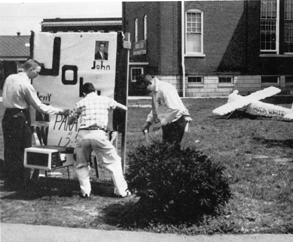 In January, the Board discussed the integration of Asbury at length. At the suggestion of Paul Rees, a trustee, a committee was formed to collect information and make a report for the Board’s consideration in one year’s time.
In January, the Board discussed the integration of Asbury at length. At the suggestion of Paul Rees, a trustee, a committee was formed to collect information and make a report for the Board’s consideration in one year’s time.
Also in January H.B. Sims, Sr., became mayor of Wilmore for the second time.
A powerful revival began in chapel on March 1, during a regular message by Professor Leon Fisher. Students soon lined up to confess and testify. The meeting lasted until late Monday night.
In June the first “Miss Asburian,” Ruth Ann Colvin, was elected.
The new addition to the library was finished.
Tenure was instituted for faculty, and the entire faculty, except those who had been working less than three years, was covered by it in one stroke. In the future, faculty were to be hired on a “probationary basis” for the first three years, after which tenure came automatically.
A part of the College farm was opened for subdivision development. In this first phase of the Talbott Subdivision, 27 lots were offered.
The fall revival was a joint affair, with the college, seminary and Methodist church. E. Stanley Jones was the speaker, and average attendance was the highest yet recorded.
1959
At their January meeting the Committee on Integration, chaired by H.H. Waller, made its report. It was a disappointment to those who favored positive action. The Committee’s unanimous recommendation was that “in light of the tense situation that has developed across our country and among our constituency over the situation of integration,” the Board take no action. A substitute motion calling for express approval of “the principle of admitting qualified students of any race to Asbury College” was tabled against the sponsor’s wishes by a vote of 11 to 9.
Mortified, E. Stanley Jones wrote to Johnson to denounce the decision. It was one thing for Asbury to develop in a social order where segregation was taken for granted. Now the College had deliberately chosen to remain segregated. Aside from being shameful and a “real blow to the spiritual life of the institution” and its influence as a missionary organization, Jones declared that this decision threw Asbury into alignment with the “dying past. For the future belongs to man as man, and not to man as white man.” Jones was not certain if he were still on the Board, but he resigned anyway.
In April Johnson tried to assure the College alumni, who had shown in a survey that they overwhelmingly supported integration, that the issue was not dead. He proposed a compromise plan that would allow “a gradual form of integration,” which he hoped to convince the Board to approve for the fall of 1960.
Construction began on an additional men’s dormitory, named for the trustees. In addition, plans were made for new science and fine arts buildings to be finished in time for the celebration of the College’s “Diamond Jubilee” in 1965.
The name of the venerable Student Volunteer Movement was changed to the Foreign Missions Fellowship.